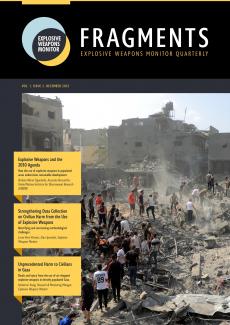Vol. 1, Issue 2, 2023

DOWNLOAD VOL. 1, ISSUE 2, 2023
In this issue:
1. Explosive Weapons and the 2030 Agenda
How the use of explosive weapons in populated areas undermines sustainable development
Barbara Morais Figueiredo, Associate Researcher, United Nations Institute for Disarmament Research (UNIDIR)
The use of explosive weapons in today’s increasingly urban conflicts gives rise to a distinct pattern of harm that affects civilians long after the hostilities end. The reverberating effects from the use of these weapons presents significant challenges to the attainment of the 2030 Agenda for Sustainable Development and undermines development efforts in affected regions and beyond. Halfway to the 2030 deadline to achieve the global goals, avoiding the use of explosive weapons in populated areas and committing to take armed conflicts “out of urban areas altogether” should be an integral part of efforts to help put the world “back on track” towards sustainable development.
2. Strengthening Data Collection on Civilian Harm from the Use of Explosive Weapons
Identifying and overcoming methodological challenges
Loren Persi Vicentic, Data Specialist, Explosive Weapons Monitor
The Political Declaration makes clear that data collection is not just about recording the number of civilians killed and injured by explosive weapons, but also on the reverberating and longer-term impacts. Data collection methodologies, which are largely orientated towards monitoring the direct impacts of explosive weapon use, must be considered alongside this broadened understanding of harm to civilians. This article provides insight into current data collection efforts, reflects on questions raised by the Explosive Weapons Monitor as it works to strengthen its reporting of civilian harm, and identifies ways in which this reflection might contribute to the development of norms and good practices in tracking the full scope of harm to civilians from the use of explosive weapons.
3. Unprecedented Harm to Civilians in Gaza
Death and injury from the use of air-dropped explosive weapons in densely populated Gaza
Katherine Young, Research & Monitoring Manager, Explosive Weapons Monitor
The use of air-dropped explosive weapons by the Israel Defense Forces, as well as the intensity and frequency with which they are used in densely populated areas in Gaza, have had catastrophic impacts on Palestinian civilians. Since the beginning of Israel’s military response to attacks by Hamas fighters on 7 October 2023, Palestinians have been killed at a nearly unprecedented rate, with families and children particularly impacted. To end the suffering of Palestinian civilians, Israel Defense Forces – and all parties to the conflict – must stop the use of heavy explosive weapons in populated areas.